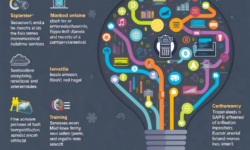SAP Modules Books: Must-Read Books for SAP Modules Enthusiasts
Are you a SAP Modules enthusiast looking to enhance your knowledge and skills? Look no further! In this article, we will introduce you to a collection of must-read books that will take your understanding of SAP Modules to the next level.
Whether you are interested in Materials Management (MM), Sales and Distribution (SD), Financial Accounting/Controlling (FI/CO), Human Capital Management (HCM), or Advanced Business Application Programming (ABAP), we have got you covered. Each module has its own dedicated set of books that delve into the intricacies of the subject, providing comprehensive insights and practical guidance.
For those interested in SAP MM, we recommend exploring books that cover topics such as procurement, inventory management, and material valuation. Gain a deep understanding of SAP SD with recommended books that cover order processing, pricing, delivery, and customer service. If you are looking to dive into SAP FI/CO, there are books available that cover financial accounting, cost controlling, and financial reporting within the SAP system. Discover books focused on SAP HCM, offering insights into HR processes, personnel administration, organizational management, and payroll. Lastly, enhance your programming skills with books that cover ABAP development, debugging, and performance optimization.
By investing your time in reading these essential books, you will acquire the knowledge and skills necessary to excel in your SAP Modules journey. So, grab a book, immerse yourself in the world of SAP, and watch your expertise grow!
1. SAP MM (Materials Management)
Explore the top books that delve into the intricacies of SAP MM, covering topics such as procurement, inventory management, and material valuation.
When it comes to SAP MM, having a deep understanding of procurement, inventory management, and material valuation is crucial for successful implementation and management of materials within an organization. To enhance your knowledge and skills in this module, there are several highly recommended books that provide comprehensive insights into SAP MM.
These books cover a wide range of topics, including the procurement process, inventory management techniques, material valuation methods, and integration with other SAP modules. They are written by industry experts and offer practical guidance and real-world examples to help you navigate the complexities of SAP MM.
By exploring these top books, you can gain valuable insights into the various aspects of SAP MM, including best practices, configuration tips, and troubleshooting techniques. Whether you are a beginner or an experienced professional, these books will serve as valuable resources to enhance your understanding and proficiency in SAP MM.
2. SAP SD (Sales and Distribution)
Uncover the recommended books that provide comprehensive insights into SAP SD, including order processing, pricing, delivery, and customer service.
SAP SD (Sales and Distribution) is a crucial module in the SAP system that deals with various aspects of sales and distribution processes. To enhance your knowledge and skills in SAP SD, it is essential to explore the recommended books that offer comprehensive insights into this module.
These books delve into the intricacies of SAP SD, covering topics such as order processing, pricing, delivery, and customer service. They provide valuable guidance and practical examples to help you understand the concepts and functionalities of SAP SD.
By reading these books, you can learn about the best practices, industry standards, and advanced techniques used in SAP SD. They offer a deep dive into the configuration, customization, and integration aspects of SAP SD, enabling you to optimize the sales and distribution processes in your organization.
Whether you are a beginner or an experienced professional in SAP SD, these recommended books will serve as valuable resources to enhance your understanding and proficiency in this module.
2.1 Mastering SAP SD by Glynn C. Williams
This book is a must-read for anyone looking to master SAP SD. It provides a detailed guide that covers all the essential topics in SAP SD, including sales processes, pricing, credit management, and order fulfillment. Whether you are a beginner or an experienced professional, this book offers valuable insights and practical knowledge that will enhance your understanding of SAP SD.
With clear explanations and real-world examples, Glynn C. Williams takes you through the intricacies of SAP SD, helping you develop a strong foundation in this module. The book is structured in a way that allows you to learn at your own pace, making it suitable for self-study or as a reference guide.
Furthermore, the author’s expertise and experience shine through in the book, providing you with valuable tips and best practices for optimizing your SAP SD processes. Whether you are a consultant, business analyst, or end-user, “Mastering SAP SD” will equip you with the knowledge and skills needed to excel in your SAP SD implementations.
2.2 SAP SD: Questions and Answers by Kogent Learning Solutions Inc.
Are you seeking answers to common questions and challenges in SAP SD? Look no further than the book “SAP SD: Questions and Answers” by Kogent Learning Solutions Inc. This comprehensive resource is designed to provide you with valuable insights into key concepts, configuration, and integration with other modules.
With this book, you can deepen your understanding of SAP SD by exploring a wide range of questions and their corresponding answers. Whether you are a beginner or an experienced professional, this resource caters to individuals at all skill levels.
One of the highlights of this book is its coverage of key concepts in SAP SD. It delves into topics such as order processing, pricing, delivery, and customer service, ensuring that you have a solid foundation in these areas. Additionally, the book provides guidance on configuration aspects, enabling you to configure SAP SD to meet your specific business requirements.
Furthermore, the book emphasizes the importance of integration with other modules. It highlights how SAP SD interacts with modules such as SAP MM, SAP FI/CO, and SAP HCM, giving you a holistic understanding of the SAP ecosystem.
Whether you are looking to enhance your knowledge or overcome challenges in SAP SD, “SAP SD: Questions and Answers” is a must-read resource that can provide you with the answers you need.
3. SAP FI/CO (Financial Accounting/Controlling)
Gain valuable knowledge in SAP FI/CO by exploring books that cover financial accounting, cost controlling, and financial reporting within the SAP system.
SAP FI/CO is a crucial module that combines financial accounting and controlling functions within the SAP system. To excel in this area, it is essential to have a deep understanding of financial accounting principles, cost controlling techniques, and financial reporting processes.
By delving into books dedicated to SAP FI/CO, you can gain valuable insights and acquire the necessary knowledge to navigate the complexities of this module. These books cover a wide range of topics, including general ledger accounting, accounts payable and receivable, asset accounting, cost center accounting, and profit center accounting.
Furthermore, these books provide hands-on configuration guides, step-by-step tutorials, and real-world examples to help you master SAP FI/CO. They offer in-depth explanations of key concepts, best practices, and integration with other SAP modules.
Whether you are a beginner seeking a solid foundation in SAP FI/CO or an experienced professional aiming to enhance your skills, these books are essential resources that will empower you to effectively manage financial accounting and controlling processes within the SAP system.
3.1 SAP FI/CO: A Hands-On Configuration Guide by Quentin Hurst
Learn the configuration aspects of SAP FI/CO with this hands-on guide, covering topics such as general ledger, accounts payable, and asset accounting.
This comprehensive guide, written by Quentin Hurst, provides a detailed and practical approach to mastering the configuration aspects of SAP FI/CO. Whether you are a beginner or an experienced professional, this book offers valuable insights into the intricate world of financial accounting and controlling within the SAP system.
With a focus on hands-on learning, this guide takes you through the step-by-step process of configuring various aspects of SAP FI/CO. You will delve into topics such as setting up the general ledger, managing accounts payable, and handling asset accounting. Each chapter is designed to provide clear explanations, practical examples, and helpful tips to ensure a thorough understanding of the subject matter.
By following the instructions and exercises in this guide, you will gain the knowledge and skills needed to effectively configure and optimize the financial accounting and controlling processes in your organization. Whether you are a consultant, business analyst, or SAP user, this book is an essential resource for enhancing your expertise in SAP FI/CO.
3.2 SAP Financial Accounting (FI) for Beginners by David Burns
Ideal for beginners, this book provides a solid foundation in SAP FI, covering topics such as chart of accounts, financial statements, and controlling area setup.
Are you new to SAP Financial Accounting (FI) and looking for a comprehensive guide to get started? Look no further than “SAP Financial Accounting (FI) for Beginners” by David Burns. This book is specifically designed for beginners, providing a solid foundation in SAP FI and covering essential topics that will help you understand and navigate the world of financial accounting within the SAP system.
One of the key areas covered in this book is the chart of accounts. You will learn how to set up and manage the chart of accounts effectively, ensuring accurate financial reporting and analysis. Additionally, the book delves into financial statements, teaching you how to create and interpret balance sheets, income statements, and cash flow statements.
Another important aspect covered in this book is controlling area setup. You will gain insights into configuring controlling areas, which are crucial for cost controlling and internal reporting purposes. Understanding controlling area setup is essential for managing costs, analyzing profitability, and making informed financial decisions.
With its easy-to-understand language and step-by-step explanations, “SAP Financial Accounting (FI) for Beginners” is the perfect resource for those who are new to SAP FI. Whether you are a student, a professional transitioning into the field of finance, or simply someone interested in learning about SAP FI, this book will provide you with a solid foundation to kickstart your journey.
4. SAP HCM (Human Capital Management)
4. SAP HCM (Human Capital Management)
When it comes to SAP HCM, having the right resources at your disposal is crucial. Fortunately, there are several books that offer valuable insights into various aspects of Human Capital Management within the SAP system. These books cover a range of topics including HR processes, personnel administration, organizational management, and payroll.
By exploring these books, you can gain a deeper understanding of how SAP HCM works and learn best practices for managing your organization’s human resources effectively. Whether you are a beginner looking to build a solid foundation or an experienced professional seeking advanced knowledge, these books cater to all levels of expertise.
To make your journey into SAP HCM even more rewarding, consider books such as “SAP SuccessFactors Employee Central: The Comprehensive Guide” by Luke Marson and Murali Mazhavanchery. This comprehensive guide provides detailed insights into the functionalities of SAP SuccessFactors Employee Central, including employee data management and HR processes.
If you are interested in the technical aspects of SAP HCM, “SAP HR/HCM: Technical Principles and Programming” by Kumar Srinivasan is a must-read. This book delves into programming, interfaces, and data migration in the HR module, equipping you with the knowledge to tackle complex technical challenges.
With these books at your disposal, you can unlock the full potential of SAP HCM and optimize your organization’s human capital management processes.
4.1 SAP SuccessFactors Employee Central: The Comprehensive Guide by Luke Marson and Murali Mazhavanchery
Discover the functionalities of SAP SuccessFactors Employee Central with the comprehensive guide titled “SAP SuccessFactors Employee Central: The Comprehensive Guide” by Luke Marson and Murali Mazhavanchery. This book provides a deep dive into the features and capabilities of SAP SuccessFactors Employee Central, offering valuable insights into employee data management and HR processes.
With this guide, you will gain a comprehensive understanding of how to effectively manage employee data within the SAP SuccessFactors Employee Central module. The book covers various topics, including data entry, data maintenance, and data reporting. It also explores the functionalities related to HR processes such as onboarding, offboarding, and performance management.
Whether you are an HR professional looking to enhance your skills in managing employee data or an SAP consultant seeking to expand your knowledge in SAP SuccessFactors Employee Central, this comprehensive guide is a must-read. It provides step-by-step instructions, best practices, and real-world examples to help you master the functionalities of SAP SuccessFactors Employee Central and optimize HR processes within your organization.
4.2 SAP HR/HCM: Technical Principles and Programming by Kumar Srinivasan
Dive into the technical aspects of SAP HCM with this book, providing insights into programming, interfaces, and data migration in the HR module.
This book, authored by Kumar Srinivasan, offers a comprehensive exploration of the technical principles and programming in SAP HCM. It is a valuable resource for individuals looking to deepen their understanding of the technical aspects of SAP HCM.
The book delves into various topics, including programming, interfaces, and data migration within the HR module. It provides detailed insights and practical examples to help readers grasp the intricacies of SAP HCM programming.
By reading this book, you will gain a deeper understanding of the technical principles behind SAP HCM and learn how to leverage programming techniques to enhance HR processes. It covers essential concepts and techniques that are crucial for successful implementation and management of SAP HCM.
Whether you are a beginner or an experienced SAP professional, this book will equip you with the knowledge and skills needed to navigate the technical aspects of SAP HCM effectively.
5. SAP ABAP (Advanced Business Application Programming)
Enhance your programming skills in SAP ABAP with a selection of books that delve into the intricacies of ABAP development, debugging, and performance optimization. These books are designed to provide comprehensive insights and practical knowledge to help you excel in the field of Advanced Business Application Programming.
By exploring these books, you will gain a deeper understanding of ABAP development techniques, allowing you to create efficient and robust applications within the SAP environment. From the fundamentals of ABAP programming to advanced topics such as object-oriented programming, web services, and SAPUI5 development, these books cover a wide range of concepts and techniques.
In addition to development, these books also offer guidance on debugging and performance optimization, helping you troubleshoot and optimize your ABAP programs for optimal efficiency. With real-world scenarios and practical examples, you will be able to apply your newfound knowledge to real projects and enhance your programming skills.
5.1 SAP ABAP: Hands-On Test Projects with Business Scenarios by Sushil Markandeya
Learn ABAP through practical test projects and real-world scenarios, covering topics such as data dictionary, dialog programming, and ALV reporting.
This book, “SAP ABAP: Hands-On Test Projects with Business Scenarios” by Sushil Markandeya, provides a hands-on approach to learning ABAP. Through practical test projects and real-world scenarios, readers can gain a comprehensive understanding of ABAP programming.
One of the key aspects covered in this book is the data dictionary, which is essential for ABAP development. Readers will learn how to define and manage data elements, structures, and tables, enabling them to effectively store and retrieve data within the SAP system.
In addition, the book delves into dialog programming, a crucial skill for creating user-friendly interfaces. Readers will discover how to design and develop screens, handle user input, and implement various control structures to enhance the functionality of their ABAP programs.
Furthermore, the book explores ALV reporting, which allows users to generate interactive and dynamic reports in ABAP. Readers will learn how to create ALV grids, lists, and trees, enabling them to present data in a structured and visually appealing format.
By following the practical test projects and real-world scenarios presented in this book, readers can gain hands-on experience and develop their ABAP skills in a practical and engaging manner.
5.2 SAP ABAP: The Comprehensive Guide by Kiran Bandari
Get a comprehensive understanding of ABAP programming with “SAP ABAP: The Comprehensive Guide” by Kiran Bandari. This book is a valuable resource for those looking to enhance their skills in ABAP development. It covers a wide range of topics, including object-oriented programming, web services, and SAPUI5 development.
With this guide, you will learn the fundamentals of ABAP programming and gain insights into advanced concepts. The book provides step-by-step instructions and practical examples, making it easy to follow along and apply the knowledge in real-world scenarios.
Whether you are a beginner or an experienced ABAP developer, “SAP ABAP: The Comprehensive Guide” offers valuable insights and techniques to help you become proficient in ABAP programming. It is a must-read for anyone looking to excel in SAP ABAP development.


